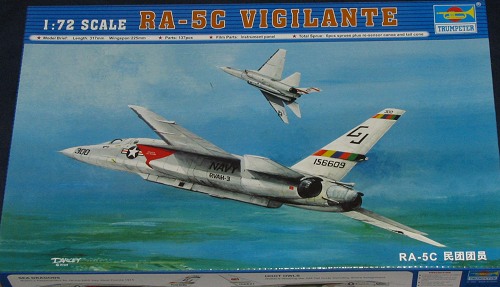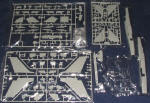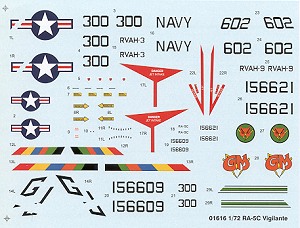
| KIT: | Trumpeter 1/72 RA-5C Vigilante (late build) |
| KIT #: | 1616 |
| PRICE: | $29.98 |
| DECALS: | Two options |
| REVIEWER: | Scott Van Aken |
| NOTES: |

| HISTORY |
The Vigilante, designed and built for the U.S. Navy by North American Aircraft Division at Columbus, Ohio, was the only Mach 2 bomber to serve aboard a Navy carrier. Initially designated the A3J-1 attack bomber, it was one of the largest and heaviest aircraft ever accepted for service aboard U.S. Navy carriers. Production began in 1956 and it entered squadron service in June 1961. It was redesignated the A-5 and fully deployed by August 1962, when the USS Enterprise, the Navy's first nuclear aircraft carrier, made its inaugural cruise.
Changing defense strategies marked a change of focus away from carrier-based, heavy attack squadrons. In 1964, all the Vigilantes were reconfigured as reconnaissance aircraft and designated RA-5C. Reconnaissance gear was mounted in what had been the Vigilante's bomb bay. Other modifications allowed the RA-5C to carry four external fuel tanks. These additions increased the airplane's range on reconnaissance missions and allowed it to keep its attack capability with externally mounted bombs and rockets.
The RA-5C Vigilante first flew on June 30, 1962, and was capable of all-weather, long-range, carrier- or land-based, multisensor, reconnaissance missions involving high-altitude supersonic, or very low-altitude, high-speed penetrations. Its inertial navigation system provided the precise position location information demanded. The Vigilante pilot and the reconnaissance/attack navigator (RAN) sat in tandem under individual clamshell-type canopies. The RAN controlled all reconnaissance functions, although the pilot could assume control of the oblique-mounted serial frame cameras. Each crewmember had a catapult/rocket-powered ejection seat, also designed and produced at the Columbus facility, capable of high-altitude, high-speed, or ground-level recoveries.
The combination of the RA-5C Vigilante's ability to deliver conventional weapons, day or night in all kinds of weather, as well as to complete tactical reconnaissance missions made it one of the most versatile aircraft in the world. RA-5Cs served throughout the Vietnam War and were retired from service in 1979.
| THE KIT |
 When
the 1/48 kit was produced, it was pretty well a given that there would be a
1/72 version as well. After all, the engineering and design work had
already been done so it was a simple job to just cut new molds. The down
side of doing things like this, is that if there are glitches in the first
kit, those will be transposed into the second. And they have.
When
the 1/48 kit was produced, it was pretty well a given that there would be a
1/72 version as well. After all, the engineering and design work had
already been done so it was a simple job to just cut new molds. The down
side of doing things like this, is that if there are glitches in the first
kit, those will be transposed into the second. And they have.
Before any major description, just what are these problem areas that have so many concerned. Well, the biggest is that the kit is covered with recessed rivets. Most un-prototypical as the aircraft is quite smooth. I'm not sure just why Trumpeter engineers did this, but hopefully they will think a bit on the next one and actually look at the subject being modeled before committing to cutting molds. The second is that the fin tip is not quite the right shape. This can be fixed to the satisfaction of most by simply using a bit of sandpaper. The third one is that the upper fuselage 'hump' is a tad too shallow. This really cannot be repaired without a lot of work, and to be perfectly frank, you really won't notice it unless set next to another model that has the proper hump height.
The kit itself is superbly molded. Fine, engraved panel lines, no sink areas, even around alignment pins, and much to my delight, no ejector pin marks on the inside of gear doors or on the landing gear legs. The cockpit is most comprehensive with good looking bang seats and instrument film to put between the instrument panel face and a backing. The wheel/tire assemblies are separate hubs that fit into tires, making for easy painting.
There is good wheel well detail for this scale, and though there are the usual insert plates for the fuselage, it should be a ton easier to fit than the old Hasegawa or Airfix kits. The wings have separate flaps, ailerons and wing tips. There are holes in the lower wing for you to attach pylons should you wish. Oddly, the stores are Mk.28 and Mk.43 bombs and not the drop tanks that were almost always carried by the fuel thirsty RA-5C. Optional flash pods are provided for the inner mounts. There are separate canopies for the pilot and BN. They can be shown open though no actuating mechanism is provided.
I can't leave this section without
commenting on a few things. First of all, the packaging for the kit is
first-rate (which is why I photographed all the sprues still in their
bags). Only one bag has two sprues in it. A huge plus to keep things from being scratched or torn off the sprue during
shipment. I only with Italeri, Hasegawa, Airfix and others would take a
clue from this, especially Italeri, who does not package the sprues at all
and lets them all float about in the box. The second is that this is a
'second build' or 156 series RA-5C. That means straight outer intakes and
the leading edge extensions to the inner wing. If doing an earlier plane,
you'll have to do a bit of cutting, sanding and to add the curved outer
intakes, a bit of conversion work with sheet styrene.
plus to keep things from being scratched or torn off the sprue during
shipment. I only with Italeri, Hasegawa, Airfix and others would take a
clue from this, especially Italeri, who does not package the sprues at all
and lets them all float about in the box. The second is that this is a
'second build' or 156 series RA-5C. That means straight outer intakes and
the leading edge extensions to the inner wing. If doing an earlier plane,
you'll have to do a bit of cutting, sanding and to add the curved outer
intakes, a bit of conversion work with sheet styrene.
Instructions are really excellent. Each step is clearly drawn with color information (Gunze, of course) provided as needed. Two markings options are given. One for RVAH-3 as shore based in Key West during 1975 (the box art plane), with the other being from RVAH-9, also with its shore based tail codes. Decals are well printed and in register. Some don't like Trumpeter decals and for those folks, no worries as Superscale and others have produced new RA-5C markings in 1/72.
| CONCLUSIONS |
What is not to like about this kit (aside from those things mentioned). It is a high quality, modern mold with lots of detail and a plane that many of us consider to be 'way cool'.
June 2005
| REFERENCES |
Thanks to your editor for the review kit.
If you would like your product reviewed fairly and fairly quickly by a site that has nearly 300,000 visitors a month, please contact me or see other details in the Note to Contributors.